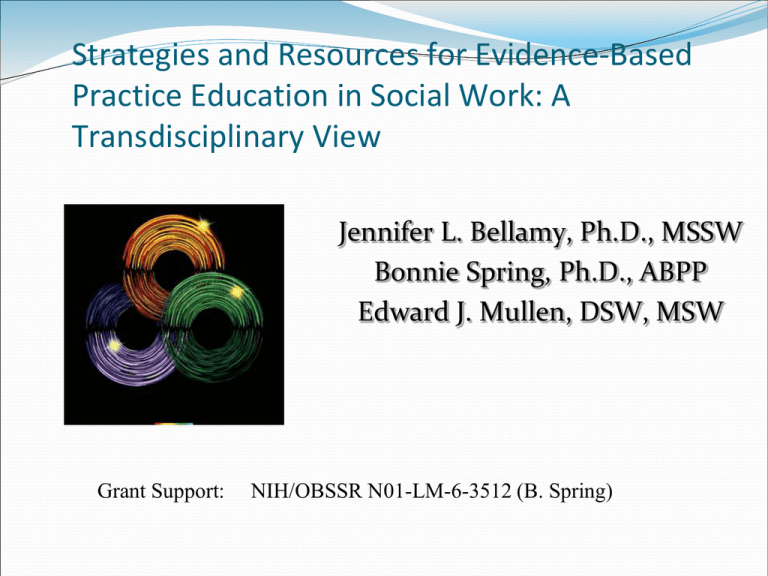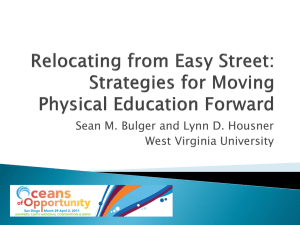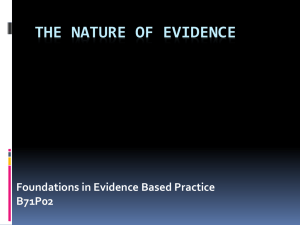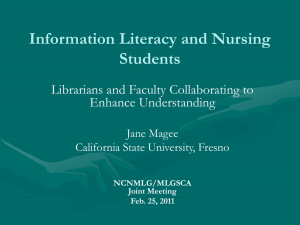Evidence-Based Behavioral Practice: Essential Skills to Identify
advertisement

Strategies and Resources for Evidence-Based Practice Education in Social Work: A Transdisciplinary View Jennifer L. Bellamy, Ph.D., MSSW Bonnie Spring, Ph.D., ABPP Edward J. Mullen, DSW, MSW Grant Support: NIH/OBSSR N01-LM-6-3512 (B. Spring) Learning Objectives 1. 2. 3. Compare and contrast the transdisciplinary model of EBBP with more traditional EBM models Locate teaching and training resources designed to support education and training on the EBBP.org website Integrate EBBP resources and competencies into social work teaching and training. Roadmap EBBP Intro and Overview Introduction to the EBBP.org website Ideas for Integration into Social Work education Discussion EBBP Introduction & Overview The Translation Challenge Uptake of scientific discoveries into clinical practice: 14% after 17 years (Balas & Boren, 2000) Only 15% of clinical practices based on evidence (IOM, 1985; Eddy 2005). EBP in Social Work CSWE Standards explicitly reference evidence-based interventions and evidence informed practice Increasing demand for EBP from the field, funders, policy makers Many social work educators have favorable views of EBP (Rubin & Parrish, 2007), but.. EBP in Social Work Most schools do not require didactic training or clinical supervision in any evidence-supported psychotherapy (Bledsoe et al., 2007; Weissman et al. 2006) Social work educators have an inconsistent understanding of EBP (Rubin & Parrish, 2007) 2003 2003 Council on Evidence-Based Behavioral Practice* Council Bonnie Spring, Ph.D. Ross Brownson, PhD Edward Mullen, MSW, DSW Robin Newhouse, PhD, RN Stephen Persell, M.D.,M.P.H. Jason Satterfield, PhD Coordinators: Molly Ferguson, MPH Stephanie Russell, MPH Advisory Board David Barlow, PhD Larry Culpepper, MD, MPH Gordon Guyatt, MD, MSc Marsha Linehan, PhD Ann McKibbon, MLS, PhD Enola Proctor, MSW, PhD Mary Jane Rotherman-Borus, PhD Kathleen Stevens, RN, EdD Steven Teutsch, MD, MPH Myrna Weissman, MSW, PhD *Supported by NIH OBSSR N01-LM-6-3512, Resources for Training in Evidence-Based Behavioral Practice Original EBM Model “conscientious, explicit, judicious use of current best evidence in making decisions about the care of individual patients” Sackett, Rosenberg, Gray, Haynes & Richardson (1996) Evidence-based medicine: what it is and what it isn’t. BMJ, 312, 71-72 Deemphasized intuitive, unsystematic clinical expertise Emphasized research. Toward a Transdisciplinary EBP Model Incorporates each discipline’s most important advances Grounded in ecological framework emphasizing shared decision-making Integrates practical consideration about resources Highlights decision-making as the process that balances evidence, client characteristics, and resources, all considered in context Transdisciplinary EBP Model Satterfield, Spring, Brownson, Mullen, Newhouse, & Whitlock (2009) Toward a transdisciplinary model of evidene-based practice Milbank Quarterly, 87(2): 368–390. Introduction to the EBBP.org website Web Tour & Training Resources www.ebbp.org Training Modules Registration is quick and free of charge Continuing Education credits for social work (soon?) Each module takes between 20-90 minutes Audio and visual style learning The modules are interactive in nature Quiz style reviews of key points Case studies and examples Embedded links to online sources, practice guidelines and other examples EBBP Process Module Addresses common misconceptions about EBP Describes the purpose of EBBP Discusses the five steps of the EBBP process Uses a smoking cessation case and a community smoking prevention example The 5 Steps of Evidence-Based Practice EBP Process Module Pre-work: Assess Step 1: Ask Background and foreground questions Background: general knowledge about a condition rather than a specific case Foreground: specific choices about action options fit to the context of resources and client characteristics (PICO) Hierarchy of evidence Example from EBBP.org Prioritize assessment questions to use time well Sequence your next steps after meeting with the client Step 2: Acquire Evidence 2. Acquire the best available evidence to answer the question Introduced in the EBBP Process Module • Detailed in Searching for Evidence Module Searching for Evidence Module Lead by a Medical Librarian Types of Evidence Types of EBBP Resources Choosing a Resource (database) Searching Techniques and Strategies Augmenting Your Search Reviewing and Revising Documenting Step 3: Appraise 3. Appraise the evidence critically for validity and applicability to the problem at hand • Introduced in the EBBP Process Module • Detailed in the Critical Appraisal, RCT, and Systematic Reviews Modules Critical Appraisal Module Focus on studies that answer questions about whether or not an intervention works Controlled Trials Time Series Systematic Reviews Review of the key study elements Sample Selection Group Assignment Data Collection Etc. Evaluation of Internal and External Validity Randomized Controlled Trials Module Definition Design and conducts of RCTs Behavior scientist practitioners engagement in RCTs via: Design and conduct of RCTs Appraising and integrating RCT evidence Applying RCT knowledge in teaching and practice Introduction to Systematic Reviews Module Definition and overview Differences between systematic reviews and traditional narrative reviews Steps for conducting and evaluating a systematic review Where systematic reviews fit in the EBBP process Step 4: Apply 4. Apply the evidence and implement the practice by engaging in shared decision- making that integrates research, client characteristics and resources in context Introduced in the EBBP Process Module Detailed in the Shared Decision Making Modules Shared Decision Making with Individuals Module Rationale for shared decision making Evaluate how expertise and resources influence intervention options Engage the client in intervention selection Locate resources and update skills by learning interventions Barriers and discrepancies between client preferences, resources and scientific evidence Collaborative Decision Making with Communities Module Similar steps as the collaborative decision making with individuals Special consideration to community level issues Engage community in collaboration from the outset Implement an ongoing evaluation of the utilization and impact of the intervention Provide regular feedback on the results of the ongoing evaluation to the community, funder, and collaborating organizations Shared Decision Making Module Example from EBBP.org Leigh Foster First Consultation (Group option) – individual therapy vs. lay support group Step 5: Analyze & Adjust 5. Analyze the new health practice and Adjust practice. Evaluate outcomes, continue or adjust course, disseminate results, identify new needs • Introduced in the EBBP Process Module • Revisited in the Shared Decision Making Modules EBBP Teaching Examples Professional Development for Practitioners and Continuing Education for Field Instructors Integration into Curriculum in: Practice related courses Research Consider anchoring the conceptual basis and basic competency in a current, pressing clinical need Current implementation EBBP.org modules in schools of social work Seeking student evaluation and feedback regarding modules and the learning objectives Two examples Strategies Being Implemented in Schools of Social Work Integration of EBBP.org modules into an Advanced Clinical Social Work Research Course Replacement of standard textbook readings of EBBP.org Modules Supplements to traditional readings on EBP, particularly related to shared decision making Reinforcement of more challenging concepts (particularly evaluation of the quality of research) Strategies Being Implemented in Schools of Social Work Integration of EBBP.org modules into an Adult Psychopathology and Wellness class Integration of the EBP process module as an introduction to EBP Paired with Drake et al.’s Evidence Based Mental Health Practice Text readings on EBP and clinical decision making EBBP Call to Action and Discussion Where can you integrate the EBBP.org resources into your teaching? What other supports or training would you like to see to support your use of EBBP.org in social work education?







